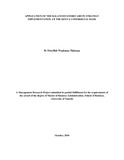| dc.description.abstract | Strategic management has become a very vital aspect in the 21st century organization. This has
been informed by the need for organizations to survive and prosper in an environment that is
fraught with challenges. Although there has been an increase in the number of organizations
embracing the process, few are able to bring it to its logical conclusion, which is the realization
of the strategies so contemplated.
This has become a weighty matter in strategic management circles, because the process leading
to these strategies is costly and yet more often than not little or no benefit that results from it.
Again, for most organizations, the process is not merely cosmetic, as ingrained in it is a genuine
desire to move from the present state of affairs to a better state in terms of growth, profitability,
market share etc.
Researchers have developed various tools for implementing strategy. One of them is the
balanced scorecard, a brain child of Kaplan and Norton, (2005). It consists of four perspectives
that is, financial, customer, internal business process and learning and growth. It has been used
as a means to clarify and translate vision and strategy, provide communication and linkage, plan
and set targets and provide strategic feedback and learning.
The Kenya Commercial Bank adopted this tool to manage performance and implement strategy
in the year 2005. The objectives of this study are to determine the application of this tool to this
end and if there are any challenges that have been faced in the process.
To achieve this purpose, a case study was carried out.9 out of the 10 targeted members of staff
were interviewed. The findings indicate that the balanced scorecard has been a useful tool for
bringing the attainment of the mission of the Bank. This is explained by the ability of this tool to
bring consensus around the vision and therefore chart the way for its execution. Some challenges
have been faced including resistance to change, lack of sufficient knowledge of the staff, aspects
of operation that are difficult to measure and lack of objectivity in appraisal of staff. | en |

